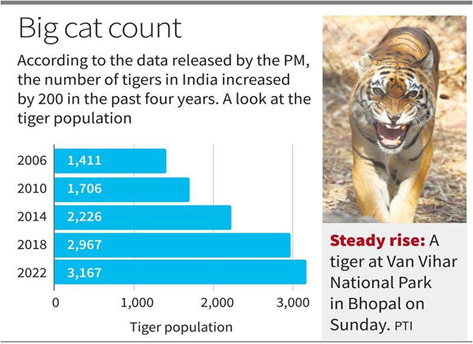

10th April 2023 (6 Topics)
Context
The tiger population numbers were made public by Prime Minister, at an event to mark the International Big Cat Alliance conference as well as the 50th anniversary of Project Tiger.
Key Findings of Tiger Census, 2022:
- According to recent findings, India has at least 3,167 tigers in total.
- This is ostensibly an increase since the last census of 2018.
- There were 2,967 tigers recorded in 2018, and 2,226 in 2014.
- Regional upgradation:
- The tiger population has grown the most in the Shivalik hills and Gangetic flood plains, followed by central India, the northeastern hills, the Brahmaputra flood plains, and the Sundarbans.
- There was a decline in the Western Ghats numbers.

Fourth Tiger Census 2018: (The last census)
- The 2018 tiger census uses more technology including a mobile app named “MSTrIPES” for the very first time to store information on the counting.
|
Another primary focus of the Tiger Census 2018 is to cover northeast India which was not included in the previous census. |
- For the very first time, three neighbouring countries Bhutan, Nepal and Bangladesh are helping in counting the number of tigers all across India, especially in the region with mutual borders.
- Madhya Pradesh saw the highest number of tigers, closely followed by Karnataka and Uttarakhand.
- Chhattisgarh and Mizoram saw a decline in tiger population and all other States saw a “positive” increase.
- Pench Tiger Reserve in Madhya Pradesh recorded the highest number of tigers; Sathyamangalam Tiger Reserve in Tamil Nadu registered the maximum improvement.
|
International Big Cat Alliance conference (IBCA):
|
Need for Tiger Conservation:
- Barometers of Ecological health: Tigers are indicators of the ecological wellness of planet Earth. Being the dominant predators of the ecosystem, they ensure that the numbers of herbivores like deer are kept balanced
- Umbrella species: Tiger is an umbrella species whose conservation eventually leads to the conservation of many other species such as the ungulates, pollinators and other small animals.
- Carbon storage value: Poaching or killing of large-bodied vertebrates such as tigers results in an increase of herbivore population, which in turn results in forests getting decimated
- The decline in the tiger population: There is a tremendous decline in the tiger population as compared to the past 100 years and to prevent the deteriorating condition of tigers, it’s important to conserve them.
About Project Tiger:
- Project Tiger is a tiger conservation programme launched in April 1973 by the Government of India during Prime Minister Indira Gandhi's tenure.
- Aim:
- The project aims at ensuring a viable population of Bengal tigers in their natural habitats, protecting them from extinction, and preserving areas of biological importance as a natural heritage forever representing as close as possible the diversity of ecosystems across the distribution of tigers in the country.
- It is a Centrally Sponsored Scheme of the Ministry of Environment, Forest and climate change.
- The project is administered by the National Tiger Conservation Authority (NTCA).
- While it initially covered nine Tiger Reserves(Manas, Palamau, Simlipal, Corbett, Ranthambhore, Kanha, Melghat, Bandipur and Sundarban) spread over 18,278 sq km, India now has 54 such reserves covering more than 75,000 sq km (approximately 2.4% of the country’s geographical area).
|
National Tiger Conservation Authority (NTCA):
|
More Articles

